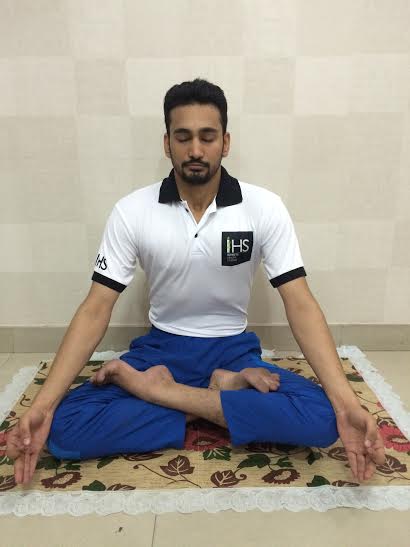
Kapalbhati
INTRODUCTION AND PROCEDURE :
- 1. Kapalbhati (or Kapalabhati) is one of the six essential Shatkarmas and one of the procedures of internal purification in Hatha Yoga.
- 2. In Sanskrit, ‘Kapal’ means the skull (includes all the organs in the skull too) and ‘Bhati’ means to shine or illuminate. Due to the process, the organs in and under the skull mainly the brain, small brain and any of the spaces inside the head which are connected to the back of the nose (sinus) are positively influenced.
- 3. The technique of Kapalabhati includes small and strong forceful exhalations and inhalations happen automatically.
- 4. Rechaka means the exhalation is forceful and rapid, while the inhalation is normal and is also known as Puraka.
- 5. The forceful exhalation blows out the stale air from the lungs and the deep inhalation increases the oxygen level in the blood.
- 6. Kapalbhati has to be practiced in a steady position along with relaxing of the muscles and the spine in a erect position.
- 7. While practicing this pranayama, posture should be properly locked because it gets difficult to maintain and hold the posture when every part of the body moves and vibrates.
- 8. In normal breathing, inhalation is the active process while exhalation is passive whereas in Kapalbhati this is reversed. The abdominal muscles and the diaphragm are used to forcefully exhale the air. The abdominal muscles forcefully move inwards towards the diaphragm thereby exhaling the air out.
- 9. This is a regular practice without any rest between two respirations. Initially one can start with 11 rounds. Later increase it to 60 rounds in one minute. Each inhalation and exhalation should take just one second.
- 10. With possible practice, subsequently, one can increase the speed to 120 rounds per minute. When every inhalation and exhalation takes only half a second.
- 11. Breathing usually becomes quiet shallow and cannot be useful in increasing capacity of speed.
- 12. The relaxation period during the practice can be roughly between 30 seconds to a minute.
- 13. At initial level one should practice about 3 times. For instance, if we practice at a continuous rate of 60 rounds per minute, then we will complete a total of 180 rounds with a gap after every 60 rounds, to relax.
BENEFITS :
- 1. It helps in cleaning the cranial sinuses and also helps in relieving cerebral thrombosis.
- 2. It purifies the nerves and the pranic channels.
- 3. It helps in removing the excess Kapha Dosha from the body.
- 4. This is a good practice of meditation and soothes in clearing mind and helps to control thoughts.
- 5. The Hatha Yoga Pradeepika claims that all impurities of the body can be removed by practice of Kapalbhati.
- 6. Kapalbhati is the best practice available to oxygenate the blood.
- 7. This practice helps obese people in removing fat from the abdominal region and also strengthens the abdominal muscles.
- 8. This practice helps in regulation of the breathing mechanism.
- 9. It is very useful in preparing the body and mind to take up advanced practices of Pranayama.
PRECAUTIONS :
- 1. While practicing this, one should be cautious that correct procedure is followed so that there are no complications.
- 2. Hypertension, heart or lung, stroke or epilepsy, hernia patients should avoid this practice.
- 3. People suffering from some illness or low stamina should avoid doing this pranayama very often.
- 4. Do not practice this pranyama in pregnancy and lactating period.
- 5. Any surgery related with thorax and abdomen, one must avoid the practice.
- 6. Ulcers patients should practice cautiously.
MEDITATIONAL POINT :
- 1. Kapalbati helps in activating your Anahat and Manipura chakra improving your lung capacity, blood circulation, digestion and imbalances in the system. It also helps in cleansing of nadis and increases of the flow of prana and shakti throughout the body

